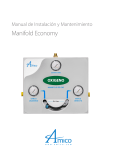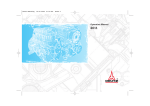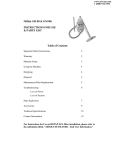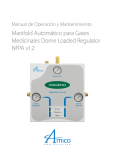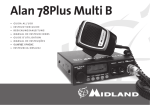Download Manual - Amico
Transcript
Installation & Maintenance Manual Automatic Dental Manifold w w w . a m i c o . c o m Contents User Responsibility 3 Introduction4 Features4 Description of the Manifold Shipment Details The Manifold Enclosure 5 5 5 Description of the Parts 6-8 Manifold Display Board 6 Regulators7 Hoses7 Sensors7 Control Buttons 8 Mute8 Stand-By8 Check Valves 8 Remote Alarm/Controller 8 Installation Instructions Installation of the Manifold Installation of the Remote Alarm/Controller Regulator Settings Display Functions 9-10 9 10 11 11 Testing12-15 Testing for N2O Emergency Cut-Off 12 Testing for Automatic Change Over 13 Switching In-Use Cylinder 14 System Stand-By 14 Testing the System 15 Testing the Remote Alarm/Controller 15 2 Cylinder Changing Procedures 16 Optional Equipment 17 Amico Corporation USER RESPONSIBILITY Manifold M i c Responsibility roprocessor Digital User The information contained in this Installation and Maintenance Manual, pertains only to the ALERT-2 USER RESPONSIBILITY based digital manifold. This product willpertains perform intoconformity with the Dental descriptions Themicroprocessor information contained in this Installation and Maintenance Manual only the Amico Automatic contained in this will manual when assembled, operated, maintained in accordance Manifold. This product perform in conformity with the descriptions contained and in thisserviced manual when assembled, with the Microprocessor Digital Manifold installation instructions provided. operated, maintained and serviced in accordance with the installation instructions provided. The contained in this Installation andParts Maintenance to the ALERT-2 The information manifold must be checked periodically. that are Manual, broken,pertains missing,only worn, distorted or microprocessor based digital manifold. This product will perform in conformity with the descriptions Thecontaminated, Amico Automaticmust Dentalbe Manifold incorporates the latest microprocessor technology for change over and alarm replaced immediately. Should such repair or replacement become necessary, contained in thisAmico manual when assembled, operated, maintained and of serviced accordance control. Thecontact manifold has beenCorporation designed to be to distributors. use while providing a high level reliability.inThis manual will with the please oreasy their installation instructions provided. enable the customer to install, use and maintain the manifold properly. Installing CO2 and N2O manifolds outdoors. Please refer to NFPA Code: 5.1.3.3.1.8 Central The manifold must checked periodically. Parts dioxide that areshall broken, missing, worn, distorted or supply systems forbenitrous and carbon bepertains prevented The information contained in thisoxide Installation and Maintenance Manual, only from to the reaching ALERT-2 must be replaced immediately. Should such repair or replacement become necessary, Thecontaminated, manifold must be checked periodically. Parts that are broken, missing, worn, distorted or contaminated must be temperatures lower themanifold. recommendations theperform centralinsupply system’s manufacturer, microprocessor basedthan digital This productofwill conformity with the descriptions please contact Amico Corporation or their distributors. replaced immediately. Should such repair or replacement become necessary, please contact Amico Corporation or its but shall never be lower thanassembled, -7°C (20°F) or greater than 54°C contained in this manual when operated, maintained and(130°F). serviced in accordance with the distributors. Installing CO2 and N2O manifolds outdoors. Please refer to NFPA Code:approval 5.1.3.3.1.8 installation instructions provided. All Manifolds should not be repaired or altered without prior written by Central Amico supply systems for nitrous oxide and carbon dioxide shall be prevented from reaching Corporation or it’s distributors. Failure to comply will void all warranty on the manifold. The manifold must should be checked periodically. that are broken, missing, worn, distorted Equipment under warranty repaired or altered Parts without priorcentral written approval Amico Corporation or or temperatures lower thannot theberecommendations of the supplyfrom system’s manufacturer, contaminated, must be replaced immediately. Should such repair or replacement become necessary, its but distributors. Failure tobe comply will void all warranty the Statements in this manual preceded by(20°F) theon words WARNING, DANGER and NOTE are of shall never lower than -7°C or manifold. greater than CAUTION, 54°C (130°F). please contact Amico Corporation or their distributors. special significance. Please read these sections carefully. All Manifolds should not be repaired or altered without prior written approval by Amico Installing CO2 and N2O manifolds outdoors. PleaseDANGER refer to NFPA Code: 5.1.3.3.1.8 Central Statements in this manual by the words WARNING, CAUTION, andwarranty NOTE are ofon special significance. Corporation or it’spreceded distributors. Failure to comply will void all the manifold. supply systems nitrous oxide and carbon dioxide shall be prevented from reaching Please read these sectionsfor carefully. Statements in this manual by the words WARNING, CAUTION, NOTE are of temperatures lower thanpreceded the recommendations of the central supplyDANGER system’sand manufacturer, special significance. Pleasethan read-7°C these(20°F) sections carefully. but shall never be lower or greater than 54°C (130°F). USER RESPONSIBILITY All Manifolds should not bedenotes repaired or which altered without WARNING: steps can preventprior injury.written approval by Amico Corporation or it’s distributors. Failure to comply will void all warranty on the manifold. Statements in this manual preceded by the words WARNING, CAUTION, DANGER and NOTE are of special significance. Please read these sections carefully. WARNING: Denotes which can prevent injury. injury. WARNING: denotessteps steps which can prevent CAUTION: denotes steps which can prevent damage to equipment. CAUTION: Denotes steps which can prevent damage injury. to equipment. WARNING: denotes steps which can prevent CAUTION: denotes steps which can prevent damage to equipment. DANGER: Denotes steps which can prevent electrical electrical shock to equipment equipment or to DANGER: denotes steps which can prevent shock to or prevent and/or death. prevent serious injuryserious and/orinjury death. CAUTION: denotes steps which can prevent damage to equipment. DANGER: denotes steps which can prevent electrical shock to equipment or to prevent and/or NOTE:serious Denotesinjury steps that pointdeath. out helpful information. DANGER: denotes steps which can prevent electrical shock to equipment or to prevent serious injury and/or death. Page: 4 www.amico.com 3 Introduction The Amico Automatic Dental Gas Manifold is designed to provide a reliable, uninterrupted supply of gas to a dental facility. The manifold has the ability to control up to four high pressure cylinders divided into two equal banks per gas. The active bank is designated as the primary or In Use source of gas, while the other bank will serve as a secondary or Reserve source. A display of LED's on the front of the manifold indicates the status of the gas supply. Each gas will have two multicolor LED's that will show the status of each cylinder. The following colors indicate the status of each cylinder: • Green - In Use • Yellow - Stand-By/Ready • Red - Empty When the primary cylinder has been depleted, the manifold will automatically switch to the secondary reserve cylinder without interrupting the supply of gas to the facility. The red LED will illuminate and an alarm will sound when a bank has depleted and requires replacement. The Amico Automatic Dental Gas Manifold is designed in accordance with the National Fire Protection Association (NFPA 99). FEATURES: • Input power to the manifold is 13.5 VDC, 1.7 A • Incorporates six multicolored LED's (three per gas) with two large LED digital pressure displays • High pressure cylinder regulators • Manifold complies with NFPA 99 • Line sensors can be mounted within the Amico zone valve box for remote installations • The line sensor module is the smallest, computer-calibrated, temperature-compensated sensor in the industry • Self-diagnostic circuitry with error display for problem identification • Highly accurate, solid state pressure Piezo-resistive transducer • Integrated dry contacts for additional remote monitoring (for multiple locations and building management systems) 4 Amico Corporation Description of the Manifold SHIPMENT DETAILS The manifold system will contain the following items: • Manifold control panel (with power supply assembly) • Remote alarm/controller (RAC) • 2x Oxygen high pressure regulators • 2x Nitrous oxide high pressure regulators • 2x DISS oxygen hoses • 2x DISS nitrous oxide hoses • 2x Double tank restraints Microprocessor Digital Manifold • Installation, operation and service manual USER RESPONSIBILITY The information contained in this Installation and Maintenance Manual, pertains only to the ALERT-2 microprocessor based digital manifold. This product will perform in conformity with the descriptions The manifold is designed to be mounted directly to a wall that is capable of supporting the equipment. contained in this manual when assembled, operated, maintained and serviced in accordance with the installation instructions provided. The manifold must be checked periodically. Parts that are broken, missing, worn, distorted or contaminated, must be replaced immediately. Should such repair or replacement become necessary, please contact Amico Corporation or their distributors. Installing CO2 and N2O manifolds outdoors. Please refer to NFPA Code: 5.1.3.3.1.8 Central supply systems for nitrous oxide and carbon dioxide shall be prevented from reaching temperatures lower than the recommendations of the central supply system’s manufacturer, but shall never be lower than -7°C (20°F) or greater than 54°C (130°F). THE MANIFOLD ENCLOSURE All Manifolds should not be repaired or altered without prior written approval by Amico Corporation or it’s distributors. Failure to comply will void all warranty on the manifold. Statements in this manual preceded by the words WARNING, CAUTION, DANGER and NOTE are of special significance. Please readthis these sections carefully. is NEMA-1 (general purpose applications only). The enclosure on manifold WARNING: denotes can preventmust injury. CAUTION: Tsteps hiswhich cabinet not be mounted outdoors. The manifold has a door that opens to allow full access to internal components. The pre-assembled circuit board is CAUTION: denotes steps which can prevent damage to equipment. located on the inside of the door allowing easier access. This design will reduce installation time and eliminate the risk of improper installation since all the components of the manifold are connected and tested at the factory. DANGER: denotes steps which can prevent electrical shock to equipment or to prevent serious injury and/or death. Page: 4 www.amico.com 5 Description of the Parts Manifold Display Board The LED's on the front of the Manifold indicate that status of each cylinder. Each cylinder is represented by a lit LED. CYLINDER LED's Primary (In Use) bank Solid green Reserve (Ready) Solid yellow Empty cylinder Solid red Sensor not detected Flashing yellow LINE LED's Normal line pressure Solid green Low line pressure Solid red High line pressure Flashing red Sensor not detected Flashing yellow When the primary bank of cylinders is depleted, the manifold will automatically switch to the secondary bank of cylinders without interruption of gas flow to the facility. The red LED will illuminate when the cylinder has depleted (less than 40 psi total tank pressure). In the event an audible alarm is required in multiple locations of a facility, the manifold is equipped with dry contacts to allow for a remote buzzer to be installed. One or both sets of contacts may be wired to an external alarm, remote buzzer and/or a building management system to indicate when an alarm condition occurs. Dry Contacts Alarm (red) Normal (green) Remote Alarm/Controller (RAC) 6 Amico Corporation Description of the Parts For both gases, when replacement cylinders are attached to the depleted bank, the red LED goes out and the yellow LED illuminates indicating that the bank has been automatically designated as the Reserve supply. No other user interaction is required. NOTE: Always confirm total tank pressure by reading the High Pressure gauge on the regulator. This will confirm that a full tank has been installed. Connections from the manifold to the remote alarm/controller (RAC) must be made using a CAT5 or CAT6 cable (supplied by others). External power for the RAC is NOT required when connected with a CAT5 or CAT6 cable. REGULATORS The package includes gas specific regulators that contain a gas specific CGA tank fitting, a gauge and a gas specific DISS connection for the hose. The regulators need to be set Microprocessor Digital Manifold to 50 psi. These regulators can be recalibrated by removing the nut and dialing in the USER RESPONSIBILITY appropriate pressure. Fluctuation in pressure may occur as the tank pressure changes from full to empty. To reset the regulators, follow Regulator Setting Procedures on page 10. AM450 Regulator The information contained in this Installation and Maintenance Manual, pertains only to the ALERT-2 microprocessor based digital manifold. This product will perform in conformity with the descriptions contained in this manual when assembled, operated, maintained and serviced in accordance with the installation instructions provided. HOSES The manifold must be checked periodically. Parts that are broken, missing, worn, distorted or contaminated, must be replaced immediately. Should such repair or replacement become necessary, please contact Amico Corporation or their distributors. Installing CO2 and N2O manifolds outdoors. Please refer to NFPA Code: 5.1.3.3.1.8 Central supply systems for nitrous oxide and carbon dioxide shall be prevented from reaching temperatures lower than the recommendations of the central supply system’s manufacturer, but shall never be lower than -7°C (20°F) or greater than 54°C (130°F). The package contains gas specific hoses. Each hose will have one end connected to the regulator and the other end connected to the manifold. It is recommended that the All Manifolds should not be repaired or altered without prior written approval by Amico Corporation or it’s distributors. to comply will void all warranty on the in manifold. cylinders be Failure positioned against the wall a manner where the hoses do not cross Statements in this manual preceded by the words WARNING, CAUTION, DANGER and NOTE are of (e.g. left onsections wall carefully. connects to left connection on manifold). special significance. Pleasetank read these WARNING: Close all cylinders and bleed all pressure from within the manifold prior to WARNING: denotes steps which can prevent injury. removing or connecting any hoses. A manifold under pressure (even with tanks closed) may cause harm to anyone near the manifold. Gas Hoses CAUTION: denotes steps which can prevent damage to equipment. SENSORS DANGER: denotes steps which can electricalpressure shock to equipment or to (four cylinder sensors Theprevent manifold contains sixprevent internal sensors serious injury and/or death. and two line sensors) that run back to the display board. These sensors support the transducer that allow for the pressure of each cylinder to be relayed to the board. Page: 4 NOTE: Close cylinders and relieve pressure in both the manifold and the line by using the bleed valve prior to removing or servicing the sensor cover/circuit board. There are two line pressure sensors installed within the manifold. For remote installations, these sensors can be disconnected from the manifold circuit board and two remote sensors can be installed into an Amico zone valve box. With remote installation, these line sensors can be wired back to the main board. See page 17. Pressure Sensors +- +- Line Sensor Terminals www.amico.com 7 Description of the Parts CONTROL BUTTONS There are two buttons located on the front face of the manifold and on the remote alarm. They are the Mute and Stand-By buttons. Mute and Stand-By Buttons MUTE The Mute button will silence any alarms until the manifold returns to a Normal condition. After the Mute button has been pressed, the visual alarms (LED's) will remain lit until the manifold returns to a Normal condition. The alarm will sound again if another alarm occurs. The alarm will not be cleared until the condition has been corrected. The Mute button also serves as a test button. If the Mute button is held for 5 seconds, the manifold will run through a self-diagnostic test and return to the current status. STAND-BY By pressing and holding the Stand-By button for five seconds, the manifold will go into stand-by mode, restricting the flow of both gases via the internal solenoids. As per NFPA 99, 2012 5.3.6.19.4: “it shall be mandatory that cylinder shut off valves be closed whenever the system is not in use.” This ensures that a dangerous condition will not occur if the lines are left open. Simply press the Stand-By button to return the manifold to full operation. NOTE: If equipment in the operating room has not been fully closed while in stand-by mode, the line pressure will deplete. An initial alarm may occur immediately after returning the manifold into service. Once pressures have been re-established, all alarms should clear. CHECK VALVES The manifold is equipped with internal check valves to avoid gas migration from the left side to the right side and vice versa. Check valves are located immediately after the solenoids. REMOTE ALARM/CONTROLLER The Remote Alarm/Controller (RAC) is intended to relay information from the manifold room to an area of the office that is consistently monitored. The RAC relays vital manifold information, including high/low line pressures and reserve cylinder status. The RAC will also allow the facility to place the unit in temporary stand-by mode, as well as mute any alarms. The RAC contains a speaker that provides an auditory signal when the system is in alarm mode. 8 Amico Corporation Installation Instructions INSTALLATION OF THE MANIFOLD 1. Remove contents from box and confirm that all required equipment has been supplied. Do not discard packing material until the system is in full operation. Keep all manuals and warranty cards. 2. Remove manifold from box and inspect for damage. 3. Open cabinet door to access manifold interior. 4. Make sure that there are not any wires that are disconnected from their terminals. 5. Using the manifold, mark mounting screw locations on the wall and install wall anchors if required NOTE: Use appropriate wall anchors for a secure installation. 6. It is important to centrally locate the manifold amongst all four cylinders to ensure that all hoses can reach the appropriate connections. NOTE: Position the manifold at a height that prevents any interference with the cylinders. 7. Using both the Oxygen and Nitrous Oxide pipes, connect the manifold line ports (at the top of the manifold) to the facility's main gas lines. Pipeline connections have been supplied to be brazed into the main facility line (follow all local and national codes applicable to your area). 8. Install the tank restraint brackets on the wall as per local codes. Place cylinders in tank restraints and secure. Make certain all valves have been closed. NOTE: Before connecting regulators to cylinder, momentarily open and close cylinder valve to blow out dirt and debris. 9. Install gas specific regulators in cylinders intended for operation. Be certain not to over tighten. Please check with your medical gas supplier to determine the correct torque needed to tighten the connection. 10. Using the two Oxygen and two Nitrous Oxide 6' (1.8 m) hoses, connect the appropriate hoses to the input lines located on the bottom of the manifold gas blocks. It is recommended to align cylinders on the wall in relation to the inputs on the manifold. This will allow for easier identification of tanks during setup/change-out. 11. Connect the loose end of the hoses to the gas specific DISS connection on the regulators. 12. Locate the RAC and connect using a CAT5 or CAT6 cable (cable supplied by others). See page 10. 13. Open all cylinders S-L-O-W-L-Y and check for leaks using Snoop Leak Detector. NOTE: Electrical power is required to operate the solenoids and restrict flow. Without electrical power, pressure will fill the lines. 14. Plug in manifold to a 120 V-240 V power supply (do not use extension cords). 15. Confirm that the manifold is on. www.amico.com 9 Installation Instructions INSTALLATION OF THE REMOTE ALARM/CONTROLLER 1. From the manifold room, run a CAT5 or CAT6 cable from the manifold to the planned location of the RAC. Allow approximately 12 inches of cable at either end to prevent tension on the connections. 2. The RAC requires a single gang wall mount solution (please follow local code to provide suitable rough-in box or low voltage trim). 3. Remove RAC from packaging. 4. Loose set screw (do not discard) located at bottom of box and remove front cover. Set cover aside (do not discard). 5. Plug the cable running from the manifold circuit board into the back of the RAC. Ensure the cable is “clicked” in and secure. Power up the manifold. 6. Use two screws to secure the alarm to the wall. Be careful not to overtighten. 7. Re-attach the front cover to the RAC and tighten set screw. 8. Test both function and display by proceeding with the same test procedures as the manifold (ex. Stand-By and Mute). Test to make sure all LED's are lighting in accordance with the manifold status. 10 Amico Corporation Regulator Settings 1. Look at the digital pressure reading on the manifold display and set pressure to 50 psi. 2. Confirm this pressure with the analog gauge. NOTE: Slight variation between gauge and digital display may occur. 3. Regulator setting procedure: a. Identify the regulator of the cylinder requiring the pressure change. b. Loosen the nuts securing the handle of the regulator. c. Turn the handle left to lower the pressure and right to increase the pressure. When lowering pressure, the bleed valve located on the cylinder requiring adjustment may be pushed to help relieve pressure. d. Push the bleed valve and release pressure to help stabilize the line and to establish that the desired pressure has been achieved. e. Close cabinet. f. Tighten nuts on the handle. Display Functions Microprocessor Digital Manifold 1. Power up the manifold. USER RESPONSIBILITY 2. Follow thein this Cylinder Procedures on page 15 in this manual to ensure that all cylinder connections are The information contained Installation andChanging Maintenance Manual, pertains only to the ALERT-2 microprocessor based digital manifold. This product will perform in conformity with the descriptions contained in this manual when properly assembled, operated, maintained and serviced in accordance with the secure and connected. installation instructions provided. The manifold must be checked periodically. Parts that are broken, missing, worn, distorted or contaminated, must be replaced immediately. Should such repair or replacement become necessary, please contact Amico Corporation or their distributors. 3. Check the indicator LED's for proper function. Installing CO2 and N2O manifolds outdoors. Please refer to NFPA Code: 5.1.3.3.1.8 Central supply systems for nitrous oxide and carbon dioxide shall be prevented from reaching temperatures lower than the recommendations of the central supply system’s manufacturer, but shall never be lower than -7°C (20°F) or greater than 54°C (130°F). 4. Only one green LED per gas should be illuminated and each reserve cylinder should have a yellow LED illuminated All Manifolds should not be repaired or altered without prior written approval by Amico Corporation or it’s distributors. Failure to comply will void all warranty on the manifold. (if a cylinder has dropped below 40 psi and is connected to the manifold, or a cylinder has been disconnected Statements in this manual preceded by the words WARNING, CAUTION, DANGER and NOTE are of special significance. Please read these sections carefully. from the manifold, a red LED will represent that cylinder). WARNING: DO disconnect a hose/cylinder without relieving the pressure first. Severe bodily harm may occur WARNING: denotes stepsNOT which can prevent injury. if the line is not relieved prior to disconnection. CAUTION: denotes steps which can prevent damage to equipment. DANGER: denotes steps which can prevent electrical shock to equipment or to prevent serious injury and/or death. Page: 4 www.amico.com 11 Testing TESTING FOR N2O EMERGENCY CUT OFF 1. Make sure the pressure is stable in both gases and the line pressures read 50 psi. Once this has been confirmed, close BOTH oxygen cylinder valves. 2. Open the cabinet to obtain access to the manifold blocks. Locate the dip switch on the circuit board and confirm switch #2 is in the OFF position. 3. Locate the Bleed Valve, refer to page 11. Dip Switch 4. Slowly push the Bleed Valve and release pressure on the In Use green LED oxygen cylinder. The system will change over to the reserve tank. 5. After change over has occurred, bleed the now active In Use green LED oxygen cylinder to simulate both tanks depleting. Once both pressures have depleted, both tanks will be represented with red Empty LED's and the LED display will read LO. 6. At this time, the nitrous oxide LED display will show OFF and will flash showing that the nitrous oxide has been closed due to lack of oxygen in the system. An alarm will be heard on both the manifold as well as the RAC. Cylinder LED's will show yellow while the nitrous oxide cut-off is active. 7. Open the flow of nitrous oxide in the rooms and scavenge the gases out of the room as you test the room. You should notice initial flow in the rooms, then a slowing of flow as the line pressure decreases and then eventually stopping. Close all flow in the rooms. 8. S-L-O-W-L-Y open oxygen cylinders one at a time. NOTE: When both cylinders are off and the system is empty, whichever cylinder you open first, that cylinder will become the cylinder in use. 9. Pressures should return to normal and one tank will be represented by a green In Use LED and the other represented by a yellow Reserve LED. 10. Close manifold door and note pressures. 12 Amico Corporation Testing TESTING FOR AUTOMATIC CHANGE OVER (CAN BE PERFORMED FOR EITHER GAS) 1. Make sure the pressure is stable and the line pressures reads 50 psi (pushing the Bleed Valves on all cylinders will make certain the lines are stable). Once this has been confirmed, close the cylinder valve that is represented by the green LED. 2. Push the Bleed Valve on the same side as the closed cylinder, allowing the cylinder pressure to drop. Once the pressure gets below the low set-point, the system will change over to the reserve tank previously represented by the yellow LED. The closed cylinder will show a red Empty LED and the In Use cylinder will show a green LED. 3. An alarm will sound on both the manifold as well as the RAC. You can mute the alarm using the Mute button. 4. Return the system to normal by S-L-O-W-L-Y opening the closed cylinder. Pressure will return to normal and the Empty cylinder will then be represented by a yellow Reserve LED. 1. Line Bleed Valves Bleed Valves www.amico.com 13 Testing SWITCHING IN-USE CYLINDER 1. Open the cabinet to reveal the manifold interior. Locate the switching buttons on the inside of the circuit board. Circuit Board Cover 2. Push the button and watch the LED's switch between green In Use and yellow Reserve (this function will not be allowed if the Reserve cylinder is empty or if the pressure is too high). 3. Select the appropriate cylinder for In Use. 4. Close the manifold door and note pressures. SYSTEM STAND-BY 1. To place the system in stand-by mode, push and hold the Stand-By button for five seconds on either the manifold or the RAC. This safety feature prevents the system from entering the stand-by mode if the button is pressed accidently. 2. When in stand-by mode, all solenoids will close restricting the flow of all gases. When in stand-by mode, a red LED located below the Stand-By button will illuminate. All other electronic components will turn off. NOTE: NFPA requires the cylinder tanks to be closed while the system is not in use. To put the system back in operation, push the Stand-By button. 3. Check that all LED's are in their normal status. 14 Amico Corporation Testing TESTING THE SYSTEM To test the system, press and hold the Mute button for five seconds. At this time, the manifold display will begin a selfdiagnostic test and then return to normal working condition. TESTING THE REMOTE ALARM/CONTROLLER Microprocessor Digital Manifold USER RESPONSIBILITY 1. Make certain the remote alarm controller (RAC) is connected via a CAT5 or CAT6 cable. The information contained in this Installation and Maintenance Manual, pertains only to the ALERT-2 microprocessor based digital manifold. This product will perform in conformity with the descriptions contained in this manual when assembled, operated, maintained and serviced in accordance with the installation instructions provided. The manifold must be the checkedfollowing: periodically. Parts that are broken, missing, worn, distorted or 2. Confirm contaminated, must be replaced immediately. Should such repair or replacement become necessary, please contact Amico Corporation or their distributors. a. Line pressure LED's correspond to the manifold LED's. Installing CO2 and N2O manifolds outdoors. Please refer to NFPA Code: 5.1.3.3.1.8 Central supply systems for nitrous oxide and carbon dioxide shall be prevented from reaching temperatures lower than the recommendations of the central supply system’s manufacturer, but shall never be lower than -7°C (20°F) or greater than 54°C (130°F). b. Reserve LED's are green when the Reserve is ready to use, or red when the Reserve is empty. All Manifolds should not be repaired or altered without prior written approval by Amico Corporation or it’s distributors. Failure to comply will void all warranty on the manifold. Statements in this manual preceded by the words WARNING, CAUTION, DANGER and NOTE are of special significance. Please read these sections carefully. WARNING: denotes steps which can prevent injury. CAUTION: • Tampering with gas specific connections is prohibited. Do not alter, remove or modify gas specific connections. CAUTION: denotes steps which can prevent damage to equipment. • Keep all manifold parts, tools and work surfaces free of oil, grease and dirt. These and other flammable materials may ignite when exposed to high pressure oxygen or nitrous oxide. Do not use chemicals, lubricants DANGER: denotes steps which can prevent electrical shock to equipment or to orprevent sealants serious injuryunless and/or death.specified in these instructions. • Before connecting a cylinder to the manifold, momentarily open and close cylinder valve to blow out dirt and debris. • After connecting cylinder to manifold, open the cylinder valve S-L-O-W-L-Y to allow heat of compression to dissipate. Page: 4 • Do not use flame or “sniff” tests for leaks. • Do not apply heat to any part of the manifold system. • Always secure high-pressure cylinders with racks, straps or chains. Unrestrained cylinders may fall over and damage or break cylinder valve. • Do not repeatedly bend, sharply bend, or twist hoses as damage to tubing may occur. • Do not put the manifold into operation until a qualified person has inspected and passed the installation as per NFPA 99 or other local standards. www.amico.com 15 Cylinder Changing Procedures 1. Keep the main bank valve open throughout these procedures. 2. Close the cylinder valves on all empty cylinders. 3. Disconnect the regulators from the cylinder valve outlets, using an appropriate wrench. 4. Place protective caps over the cylinder valves of the empty cylinders and move them aside. 5. Remove protective caps of the full cylinders. Visually inspect the cylinder valves for dust, grease or oil. 6. Using a clean (lint free) cloth, wipe each cylinder valve outlet clean. Do not use your fingers. 7. Standing to one side, “crack” the cylinder valve by briefly opening and closing them to blow out any dust. Make sure they are pointing away from you and other personnel. Microprocessor Digital Manifold USER RESPONSIBILITY 8. Connect the regulators to the cylinder valve outlets and tighten the nut with an appropriate wrench. The information contained in this Installation and Maintenance Manual, pertains only to the ALERT-2 microprocessor based digital manifold. This product will perform in conformity with the descriptions contained in this manual when assembled, operated, maintained and serviced in accordance with the installation instructions provided. The manifold must be checked periodically. Parts that are broken, missing, worn, distorted or contaminated, must be replaced immediately. Should such repair or the replacement become necessary, 9. Proceed to S-L-O-W-L-Y open cylinder valves one at a time. please contact Amico Corporation or their distributors. Installing CO2 and N2O manifolds outdoors. Please refer to NFPA Code: 5.1.3.3.1.8 Central supply systems for nitrous oxide and carbon dioxide shall be prevented from reaching temperatures the of the central supply system’s manufacturer, M i c r o p r o c lower e s s o than r Dig i t arecommendations l Manifold but shall never be lower than -7°C (20°F) or greater than 54°C (130°F). All Manifolds should not be repaired or altered without prior written approval by Amico Corporation or it’s distributors. Failure to comply will void all warranty on the manifold. USER RESPONSIBILITY Statements in this manual preceded by the words WARNING, CAUTION, DANGER and NOTE are of special significance. Please read these sections carefully. The information contained in this Installation and Maintenance Manual, pertains only to the ALERT-2 microprocessor based digital manifold. This product will perform in conformity with the descriptions contained in this manual when assembled, operated, maintained and serviced in accordance with the installation instructions provided. WARNING: High pressure oxygen systems must be handled with CAUTION. Spontaneous combustion may occur if oxygen comes into contact with grease or oil. Ensure that hands, gloves, clothing and tools are kept clean and free Installing CO2 and N2O manifolds outdoors. Please refer to NFPA Code: 5.1.3.3.1.8 Central supply systems for nitrous oxide and carbon dioxide shall be prevented from reaching of oil and grease. Be careful not to introduce dust or other contaminants into the system when changing cylinders. temperatures lower than the recommendations of the central supply system’s manufacturer, but shall never be lower than -7°C (20°F) or greater than 54°C (130°F). Failure torepaired comply with the procedure may be hazardous. CAUTION: denotes steps canwithout prevent damage to equipment. All Manifolds should not be orwhich altered prior written approval by Amico The manifold must be checked periodically. Parts that are broken, missing, worn, distorted or WARNING: steps which prevent contaminated, must be replaceddenotes immediately. Shouldcan such repair injury. or replacement become necessary, please contact Amico Corporation or their distributors. Corporation or it’s distributors. Failure to comply will void all warranty on the manifold. Statements in this manual preceded by the words WARNING, CAUTION, DANGER and NOTE are of special significance. Please read these sections carefully. DANGER: denotes steps which can prevent electrical shock to equipment or to prevent serious injury and/or death. WARNING: FirewhichHazard. DO NOT permit smoking, or any other source of ignition in area where the manifold is WARNING: denotes steps can prevent injury. located, or near the relief valve vent outlet. Be certain that all connections are free of dirt, grease, and oil. These substances burn with great intensity in air enriched with oxygen, or nitrous oxide and some gas mixtures. CAUTION: denotes steps which can prevent damage to equipment. Page: 4 DANGER: denotes steps which can prevent electrical shock to equipment or to prevent serious injury and/or death. Page: 4 16 Amico Corporation Optional Equipment A valve box with sensor provisions can be installed in the dental facility to monitor the line pressures downstream of the manifold. Zone valve boxes shall be an Amico Alert-1 series. Each sensor valve combo is supplied with a street-elbow (1/8" MNPT x 1/4" FNPT) to connect a DISS fitting (one for each valve). The elbow is to be installed on site with the gas specific pressure sensor. Each sensor will have a terminal block to connect the negative and positive wires. The terminal blocks shall be assembled into the valve box. Once the sensors are installed into the valve box, they can be wired back to the manifold. The cable used shall be Belden #8451 or equivalent #22 gauge shielded twisted pair (for multiple sensors a multi-conductor shielded twisted pair cable should be used). CONNECTING THE REMOTE SENSOR WIRES TO THE MANIFOLD • Unplug the manifold power connector. Open the Manifold door and locate the plate covering the circuit board. Remove bolts and take out the protective cover. • Locate the sensor wires on the manifold labelled “LINE +/-“. There is one set for each gas • Loosen the screw (counter clockwise) that holds the wire in place. GENTLY remove the wires from the location +- +- Line Sensor Terminals • Identify the appropriate gas sensor wire and connect it into the appropriate terminal, taking attention to the polarity Utility Room Operatories Optional Valve Box www.amico.com 17 Notes 18 Amico Corporation Notes www.amico.com 19 www.amico.com Amico Corporation | www.amico.com 85 Fulton Way, Richmond Hill Ontario, L4B 2N4, Canada Toll Free Tel: 1.877.462.6426 Toll Free Fax: 1.866.440.4986 Tel: 905.764.0800 Fax: 905.764.0862 Email: [email protected] APE-INSTAL-MAINT-DENTAL-MANI 08.20.2015




















